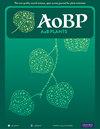Study of the genetic variability of durum wheat (Triticum durum Desf.) in the face of combined stress: water and heat
IF 2.4
3区 生物学
Q2 ECOLOGY
引用次数: 0
Abstract
The devastating effects and extent of abiotic stress on cereal production continue to increase globally, affecting food security in several countries including Tunisia. Heat waves and the scarcity of rainfall strongly affect durum wheat yields. The present study aims to screen for tolerance to combined water and heat stresses in durum wheat at the juvenile stage. Three combined treatments were tested, namely: T0 (100% field capacity (FC) at 24°C), T1 (50% FC at 30°C), and T2 (25% FC at 35°C). The screening was carried out based on morphological, physiological, and biochemical criteria. The results showed that the combined stress significantly affects all the measured parameters. The relative water content (RWC) decreased by 37.6% under T1 compared to T0. Quantum yield (Fv/m) and photosynthetic efficiency (Fv/0) decreased under severe combined stress (T2) by 37.15% and 37.22%, respectively. Under T2 stress, leaf temperature increased by 63.7%. A significant increase in osmo-protective solutes was also observed, including proline, which increased by 154.6% under T2. Correlation analyses of the combination of water and heat stress confirm that the traits RWC, chlorophyll b content (Chlb), Fv/m, proline content (PC), Fv/0, and leaf temperature (LT), can be used as reliable screening criteria for the two stresses combined. The principal component analysis highlighted that Aouija tolerates the two levels of stresses studied, while the genotypes Karim and Hmira are the most sensitive. The results show that the tolerance of durum wheat to combined water and heat stress involves several adaptation mechanisms proportional to the stress intensity.研究硬粒小麦(Triticum durum Desf.)在水和热双重胁迫下的遗传变异性
非生物胁迫对谷物生产的破坏性影响和程度在全球范围内不断加剧,影响了包括突尼斯在内的一些国家的粮食安全。热浪和降雨稀少严重影响了硬粒小麦的产量。本研究旨在筛选硬粒小麦幼苗期对水和热联合胁迫的耐受性。测试了三种综合处理,即T0(24°C,100%田间能力(FC))、T1(30°C,50%田间能力)和 T2(35°C,25%田间能力)。根据形态、生理和生化标准进行了筛选。结果表明,综合胁迫对所有测量参数都有显著影响。与 T0 相比,T1 的相对含水量(RWC)降低了 37.6%。在严重综合胁迫(T2)下,量子产量(Fv/m)和光合效率(Fv/0)分别下降了 37.15% 和 37.22%。在 T2 胁迫下,叶温上升了 63.7%。还观察到渗透保护性溶质明显增加,其中脯氨酸在 T2 胁迫下增加了 154.6%。对水分胁迫和热胁迫组合的相关分析表明,RWC、叶绿素 b 含量(Chlb)、Fv/m、脯氨酸含量(PC)、Fv/0 和叶温(LT)等性状可作为两种胁迫组合的可靠筛选标准。主成分分析结果表明,Aouija 能承受所研究的两种胁迫,而基因型 Karim 和 Hmira 则最为敏感。结果表明,硬粒小麦对水和热两种胁迫的耐受性涉及与胁迫强度成比例的几种适应机制。
本文章由计算机程序翻译,如有差异,请以英文原文为准。
求助全文
约1分钟内获得全文
求助全文
来源期刊

AoB Plants
PLANT SCIENCES-
CiteScore
4.80
自引率
0.00%
发文量
54
审稿时长
20 weeks
期刊介绍:
AoB PLANTS is an open-access, online journal that has been publishing peer-reviewed articles since 2010, with an emphasis on all aspects of environmental and evolutionary plant biology. Published by Oxford University Press, this journal is dedicated to rapid publication of research articles, reviews, commentaries and short communications. The taxonomic scope of the journal spans the full gamut of vascular and non-vascular plants, as well as other taxa that impact these organisms. AoB PLANTS provides a fast-track pathway for publishing high-quality research in an open-access environment, where papers are available online to anyone, anywhere free of charge.
 求助内容:
求助内容: 应助结果提醒方式:
应助结果提醒方式:


